 Your Mission…
Your Mission…
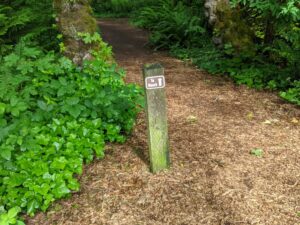
Find evidence of
barnacles and send us a photograph!
Burfoot County Park is a 65 acre park located six miles from downtown Olympia and includes over 1,000 feet of natural marine shoreline with saltwater access.
Solve the mission for the Nisqually Reach Nature Center Tide Prediction to see when the tides are low. Remember to check the tides using the Boston Harbor station for the most accurate tidal elevations and times!
When you arrive, park at the far lot and follow the loop trail through the forest to the beach.
KNOW BEFORE YOU GO
- This trail is not ADA accessible and has a series of moderately steep steps
- DO NOT CLIMB the steep shoreline bluffs!
- Dogs must be on a leash
- Pick up after your dog and dispose of pet waste in the trash
- Beware of poison oak along the trail
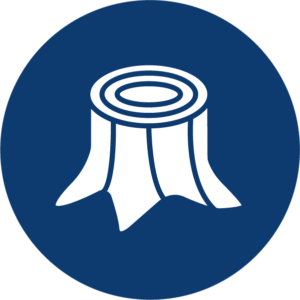 Through the Forest and to the Beach We Go!
Through the Forest and to the Beach We Go!
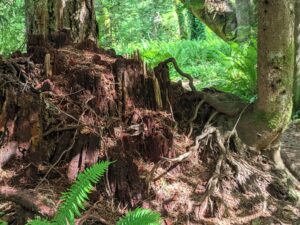
The trail takes you through a second growth or a secondary forest to the beach.
What does it mean to be a second growth or a secondary forest? Second growth forests are forests that grow after the original primary or old growth forest has been cut. Much of the Pacific Northwest forests are second and third growth forests. These younger forests have a different ecology than an old growth primary forest.
Can you find an old cedar stump from past logging days? Some of these stumps may have been 1,000 year old trees when they were cut down! Now these old features are an important part of the forest ecology supplying habitat for small animals and nutrients for 100’s of more years. Old stumps such as these and dead fallen logs with vegetation growing from them are called nurse stumps or nurse logs. How many have you seen?
![]()
Evergreen Trees
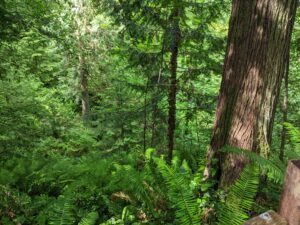
Did you know that
then Pacific Northwest has more evergreen trees than almost anywhere in the United States?
What is an evergreen tree? Trees that keep their leaves or needles all year long are called evergreens. Deciduous trees lose their leaves in fall. Washington has about 25 native tree species visit here to learn about seven most common trees in Washingtons forests.
Count how many native trees you see along the way. Notice which trees lose their leaves in fall and which do not.
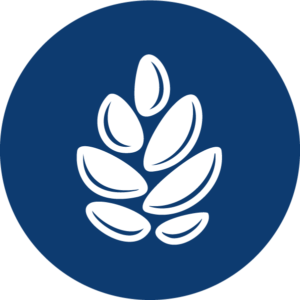 The Understory
The Understory
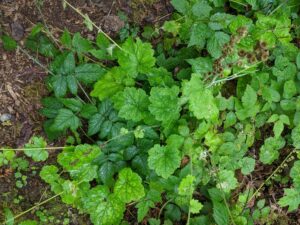
The plants growing under the trees are referred to as the understory. Burfoot Park has many native understory plants. See if you can identify these!
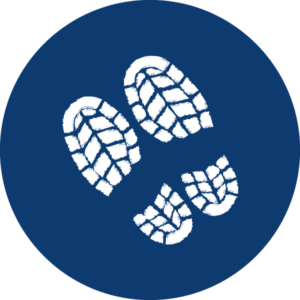 Ivy Everywhere
Ivy Everywhere
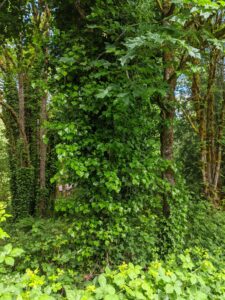
English ivy is considered to be an invasive plant meaning it is not native. Our parks suffer from many non-native invasive plants. Billions of dollars are spent controlling invasives each year as these plants spread and degrade our forests, prairies and wildlife habitat.
Why are invasive plants successful? They may
- Produce large amounts of seeds
- Grow in disturb soil
- Are aggressive and can out compete native plants for space
- Have aggressive root systems
What invasive plants can you identify?
How can you help in not spreading invasive plants?
- Remove invasive from your yard, bag them and dispose in the trash.
- NEVER dump weeds. Bag them and throw in the trash.
- DO NOT pick flowers and take them home.
- Drive only on established roads away from infested areas.
- Remove seeds from the fur of pets.
- Volunteer with your local parks! volunteer.olympiawa.gov
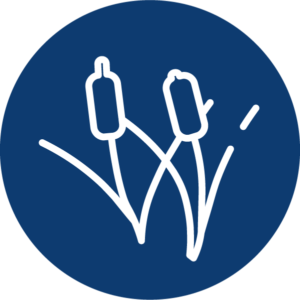 Springs and Wetlands
Springs and Wetlands
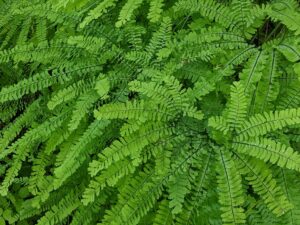
As you near the beach, the trail becomes shadier and the ground wet from springs emerging from the hillsides. The boardwalk crosses over a densely vegetated wetland with many amazing water loving plants.
Can you solve these riddles?
I am a plant that thrives in damp soils and the mist of hidden springs and waterfalls. I grow well in the shadows of big trees. I have multiple finger-like fronds with black stems and delicate leaves. What am I? Western maidenhair fern!
I grow in swampy soil wetlands and at the edges of streams where water is plentiful. I can grow in shade or partial sun and in spring I produce a brilliant yellow lantern shaped flower that is stinky and pollinated by flies. I have large, long tender green leaves and my roots can be eaten. What am I? Western skunk cabbage also known as swamp lantern!
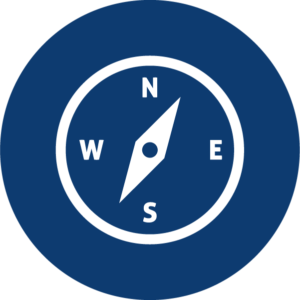 Poison Oak!
Poison Oak!
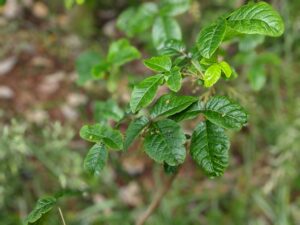
As you approach the beach entrance watch for poison oak all along the sides of the trail and on the cliff and bluff face.
Do you know how to identify this plant? If it has leaves of three let it be!
Poison oak is a native plant that often grows along the shoreline of Puget Sound and in the forest. It is a low dense shrub and in the western United states its leave may look like the lobed leaves of the oak tree. In fall its leaves may turn bright red. It may also grow as a vine along the bluff face and trees.
Did you know that you can get the poison oak or ivy rash from your pet? If your pet has the oils from the plant on its fur you can possibly break out in the nasty rash after touching. How to prevent this? Keep pets on a leash and do not allow then to wonder through the understory plants.
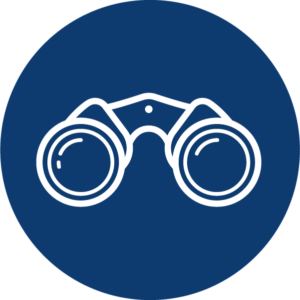 URGENT! Please stay off the Bluffs!
URGENT! Please stay off the Bluffs!
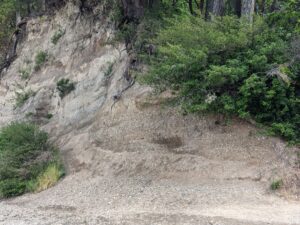
The cliffs of Burfoot Park provide sands and gravel that form our beaches and are referred to as feeder bluffs as they “feed” the beach. Climbing on the bluff creates erosion and causes chunks of the bank to fall before it’s time. It is extremely important not to climb these banks for your own safety and for the ecology of the beach.
Can you identify the different size of gravel from the bluff on the beach?
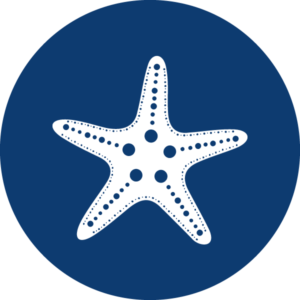 Barnacles
Barnacles
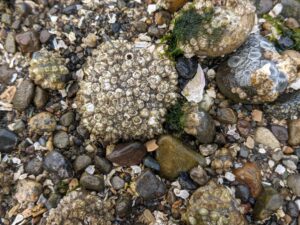
The nearshore is a rich habitat and many marine species make it their home. What animals or evidence of animals like empty shells can you find on the beach?
On the rocks and logs you will find small marine animals called acorn barnacles. Barnacles are crustaceans like crabs but unlike crabs they attach themselves to a hard surface and cannot move. They can live in the intertidal zone or the area between the high and low tide of the beach and their shells can tightly close so that they won’t dry out during low tides. Usually when you find a closed barnacle it is a live animal. Please do not take it home! Only the empty shells contain no animals. Remember to take your photo and send it to us to finish your mission!
Barnacles, crabs, sea jellies and other marine animals have reproductive larval stages that make up zooplankton (zoo (zoh) meaning animal vs. phytoplankton meaning plants of the sea) which provide food for our oceans. They are the producers making up an important part of the marine food chain or food web.
For more info visit:
https://www.youtube.com/watch?v=kARkOXPpiMU
https://study.com/academy/lesson/marine-food-chain-lesson-for-kids.html
https://www.sciencelearn.org.nz/resources/143-marine-food-webs
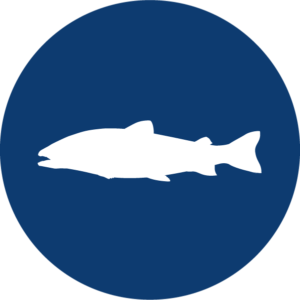 Other Marine Wildlife
Other Marine Wildlife
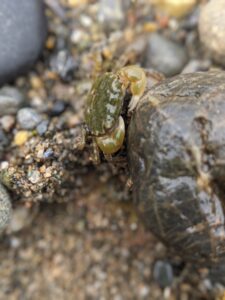
Many crabs may be found along the shoreline and under rocks. The tiny shore crab is most commonly seen under large and small rocks on our beaches. Please remember to carefully turn back the rocks that these carbs use as their homes!
During high tide along the shore small silvery fish referred to as forage fish rest and lay their eggs. The three most common forage fish found in Puget Sound are surf smelt, Pacific sand lance and Pacific herring.
Forage fish are critical to many species in Puget Sound such as sea birds like the pigeon guillemot and salmon. It is essential that we protect beach habitats to preserve healthy forage fish populations if we are to protect salmon.
 Return Forest Loop
Return Forest Loop
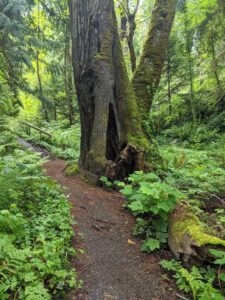
As you return, take the alternate loop trail and see what wildlife homes you can find along the way.
What animals do you think make their homes in this forest? Here are a few that you may see or see evidence of. Have you seen any of these?
Western tiger swallowtail butterfly
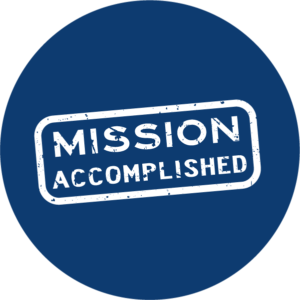 Congratulations!
Congratulations!
You have completed your mission to find evidence of barnacles and send us a photograph! Don’t forget to log in to the Goose Chase App and submit your photo for this mission to collect your park specific sticker!
